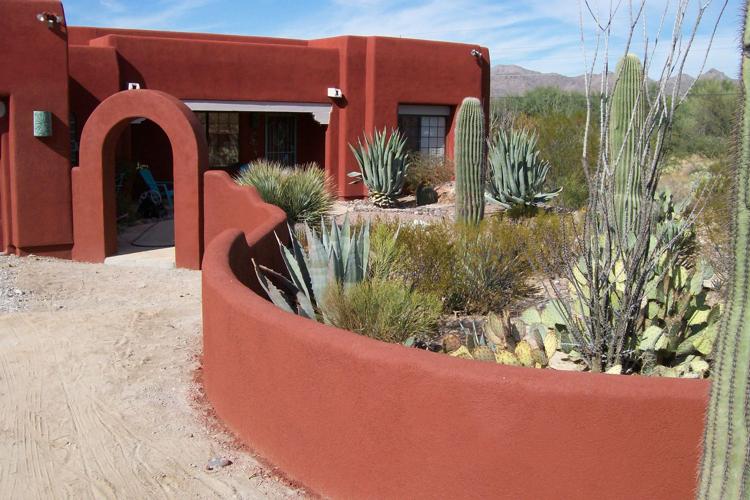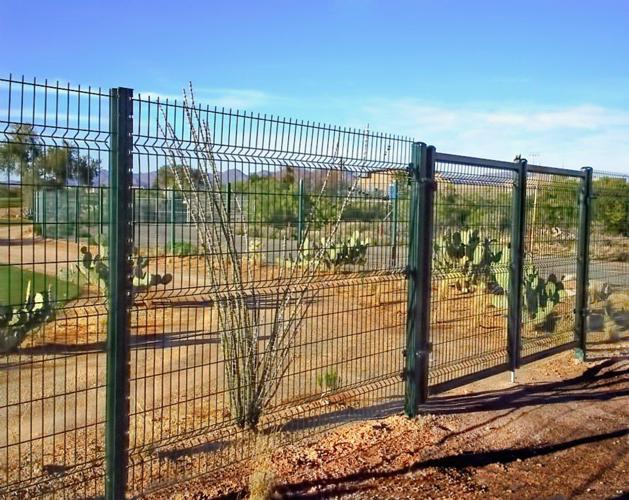The time has come for that old wooden fence.
You’ve coddled it for years. You’ve patched it, painted it, replaced sections of it, even prayed for it, hoping it still would be standing after another howling monsoon storm scattered the lawn chairs in your backyard.
Now it’s time to build that wall.
Local contractors say there’s more to think about and decide compared to the days when a gray block wall and maybe a coat of paint was good enough for just about everyone.
Steve Carlson started his business, Old Pueblo Masonry, in 1992, and has seen an evolution in the business as customers have more access to information and take the time to become more knowledgeable about their projects before they call a contractor.
“When we first started in this business, it was basically go out and build your basic block wall and everyone seemed pretty satisfied with it,” Carlson said. “There’s definitely been a change as far as the customer’s expectations. There have been quite a few times that I’ve showed up and they already had a set of plans drawn up with what they’d like to have and how they want it to look.”
But that can be a starting point, Carlson said, pointing out that most contractors have the expertise to offer suggestions even when customers think they know exactly what they want. Those suggestions are sometimes related to price. A contractor also might have ideas regarding colors and the expanding range of available textures and materials that can make a plain wall unique.
“When (customers) are thinking about walls, they’re driving around town and seeing walls everywhere. They’re paying more attention,” Carlson said. “They’ll come up with an idea, but then I might find a more affordable material. We can play around with the design of the job with different textures and materials.”
Willie Flores Jr., owner of Flores Masonry, said he also has found that by the time customers contact him they have a good idea of what they’re looking for.
“They want the wall to be 6 feet high for privacy,” said Flores, who became a registered contractor in 1992. “When I first started people were building with 4-inch-high blocks that were 6 inches and 8 inches wide. All of a sudden everybody started building with 8-inch by 8-inch by 16-inch because it’s a lot cheaper and a lot stronger.”
Carlson said getting a wall done is a process that takes about three weeks after a decision is made on a contractor and the scope of the project has been defined.
He said a contractor will provide an estimate — customers often get more than one — before a decision is made on the final specifications of a project. The contractor should provide detailed information on the construction, including the type of footing used for the wall, and all the materials. If the customer is replacing a fence, the estimate also should include hauling away the old fence.
A standard 6-foot wall with a length of 150 to 190 feet and a small amount of customization will cost about $47 per linear foot, Carlson said. Items that factor into the cost are how much there is to haul away if a fence is being replaced, as well as access to the property.
And Carlson points out that you can’t always just build the wall on the same alignment of the previous fencing.
There are easements, flood plains, property lines and underground facilities like irrigation, electrical lines and water lines to be considered when determining where the wall ultimately is built.
All that information — gathered by the contractor — has to be taken to either Pima County or the city of Tucson which will issue a permit to build the wall. If there are no issues with flood plains or other impediments, a permit can be issued in two or three days and work can begin.
One of the more common trends, Carlson said, is for a wall to include a “ribbon” in the design which usually involves a line of blocks that is different in texture and/or color to avoid having one flat look. Sometimes that is used to match a color or a texture in the landscaping or the house itself. Caps, the top block on the wall, can also add a design element to match something on the house or in the yard.
In some of the more historical neighborhoods, front walls for privacy, particularly if the property is on a busy street, are becoming common. Those walls generally require more design, such as stucco and color, to meet strict neighborhood requirements. Outside of those neighborhoods, front privacy walls tend to match the back wall, Carlson said.
For a higher-end look, A&M Fencing in Tucson specializes in metal fencing, some with ornamental designs and some with a more practical purpose such as keeping pets in the yard or keeping wildlife out. A&M built the fence for the new elephant enclosure at the Reid Park Zoo.
Matt Gage, president of A&M Fencing, said the work that goes into the design of a metal fence goes beyond the practical use of the fence.
“My philosophy is that if you’re going to pay that much, and it’s not cheap, it should be custom,” he said. “It should be a work of art. Something tailored to what you like.”
But tailoring goes on for block walls as well.
Carlson did a project in the university area where the homeowner didn’t want to trim an old tree, but there were some branches that were lower than the height of the wall.
“We actually had to leave gaps in the wall for the tree branches to go through,” Carlson said. “She did not want to trim those trees so we just built the wall up and around them and made some little openings for the branches.”
Flores was involved in a $1 million renovation near Canyon Ranch on the northeast side where he built a wall that included three 8-foot-long fire pits protruding from the wall with gas lines. The pool was built with river rock embedded in the plaster to give the pool bottom the look of a clear lake, and Flores had to incorporate some of that design in the wall as well.
Carlson said business is brisk right now.
“Customers are definitely spending more money on their back yards,” Carlson said. “They’re not all buying new houses. They’re actually taking care of what they have and making it what they want.”







